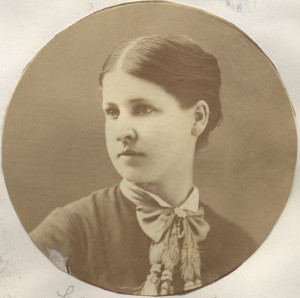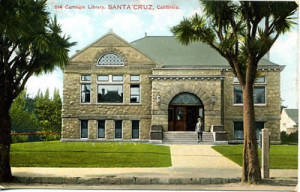Tidepooling in a Bustle: Tracing the Museum’s History
 The Museum traces its beginnings to the late 1800s and the collection of naturalist Laura Hecox. Miss Hecox was born in Santa Cruz in 1854 and from childhood had a keen interest in the natural sciences. Her parents, Adna and Margaret Hecox, traveled overland from Illinois to California in 1846 and settled in Santa Cruz the following year. In 1869 Mr. Hecox was appointed keeper of the original Santa Cruz Lighthouse and took up residence there with his wife and family.
The Museum traces its beginnings to the late 1800s and the collection of naturalist Laura Hecox. Miss Hecox was born in Santa Cruz in 1854 and from childhood had a keen interest in the natural sciences. Her parents, Adna and Margaret Hecox, traveled overland from Illinois to California in 1846 and settled in Santa Cruz the following year. In 1869 Mr. Hecox was appointed keeper of the original Santa Cruz Lighthouse and took up residence there with his wife and family.
Young Laura soon began collecting seashells, minerals, fossils, Indian artifacts, and other specimens and curios, turning part of the lighthouse into a private nature museum. “This young lady is quite a student of conchology, and her display of shells and cabinet specimens is greatly admired by all who visit the lighthouse,” said a writer in 1879.
In 1883 Adna Hecox died and Laura Hecox was appointed lighthouse keeper by the federal government. She stayed at the post for thirty-three years. On weekends she gave public tours of the lighthouse including her personal natural history museum. Although interested in all of natural history, her specialty was mollusks. She corresponded with prominent scientists of the day and had at least two mollusk species named in her honor.
First Public Museum in Santa Cruz
In 1904 Laura Hecox deeded her collection to the City of Santa Cruz for the establishment of its first public museum. The following year, the Hecox Museum opened in the basement of the new Carnegie Library, which was located on the site of the present Central Library. Dr. Charles Lewis Anderson, local physician and naturalist, served on the library Board of Trustees and played a key role in establishing both the library and museum. 
The museum opened August 21, 1905. There were displays of dried sea stars and crustaceans, Indigenous artifacts, minerals, fossils, coral, bird nests and eggs, turtle and tortoise carapaces, and several cases of shells, including two hundred local species. In a short speech, Laura Hecox said that she did not feel that she was losing anything in giving the collection but rather was merely taking everyone else into partnership with her in the enjoyment of it. The Hecox collection remained at the library until about 1917 when it was moved to the new Santa Cruz High School.
In 1929 Humphrey Pilkington bequeathed his large collection of Indian artifacts to the City of Santa Cruz under the condition that a museum be established to store and display it. Pilkington was a forester and agriculturist and was the first warden at California Redwood Park (now Big Basin Redwoods State Park).
Museum moves to Seabright
![0 R UMAX Power Look 2000 V1.8 [3]](https://www.santacruzmuseum.org/wp-content/uploads/2016/02/Seabright-Carnegie-Library-300x190.jpg)
The Crafts House, home of the Museum from 1930 to 1954, was located behind the present Museum where the amphitheater is now. The Santa Cruz Art League used the basement. In 1930, the Pilkington collection was set up at the Crafts House in Tyrrell Park in Santa Cruz’s Seabright neighborhood. A volunteer Board of Trustees was appointed by the City Council, and they elected trustee Jed Scott as first curator. In 1932, through the efforts of Curator Scott, the Hecox collection joined the Pilkington collection in Seabright. During the 1930s and 1940s a core of hardworking trustees kept the Museum going. These included Robert Burton, Mr. & Mrs. Harry Turver, Norman Pendleton, Mina Unsworth, George Croydon, and John Strohbeen. During part of this period the Museum also maintained a public aquarium on the Santa Cruz Wharf.
In 1947 the Museum Commission was established to advise the Santa Cruz City Council on Museum matters. This gave the Museum formal legal status within city government and paved the way to someday expand and hire a staff.
In 1954 the old Crafts House was condemned and the Museum moved next door to the Seabright Branch Library building which had been built in 1915. The joint Museum-Library opened October 10, 1954.
In 1960 Dr. Glenn Bradt was appointed to the Museum Commission. Dr. Bradt had a Ph.D. in mammalogy and was retired from the Michigan Department of Conservation. During his tenure as a nearly full-time Museum advocate and volunteer, two additions were built onto the old library building (in 1962 and 1968), all the exhibits were redone, and in 1969 the first full-time curator was hired. Dr. Bradt also forged ties between the Museum and the new community college and university.
Museum Becomes a Community Institution
In 1969 Charles Prentiss was hired as curator. He came to the job with a college background in both biology and art. During his twenty-nine years at the Museum, programs, staff, collections, and exhibits continued to improve and expand. In the 1970s annual exhibits such as the Fungus Fair and Spring Wildflower Show were inaugurated and the first of many special exhibits held. Thanks to hundreds of donations during this period, the Museum’s priceless collection of specimens and artifacts grew to over 16,000 items. In 1978 the Santa Cruz Museum Association formed as the Museum’s non-profit membership arm. In 1980 the Docent Program began. Today, docents give tours to 7,000 school children each year. In 1981 the interior of the Museum building was extensively remodeled and all new exhibits constructed. In 1982 the life-size gray whale model was built with funds raised by the Museum Association.
In 1984 the Museum built outdoor exhibit kiosks on the Santa Cruz Wharf featuring marine life, fishing, and wharf history. In 1986 the Surfing Museum was established as a satellite facility at the Mark Abbott Memorial Lighthouse. The fascinating displays of old surfboards and historical photographs attract 70,000 visitors each year.
In 1998 Greg Moyce, with the title Museum Director, replaced retiring curator Charles Prentiss. As the Museum entered the 21st century, it offered more programs and had greater public support than ever before. Jenifer Lienau-Thompson joined the Museum in 1998 as well, stepping into a lead role in 2005 when Greg Moyce moved to Oregon to pursue a career in exhibit design. Jenifer was instrumental in the success of the celebration of the Museum’s Centennial in August of that year.
Observing the popularity of the annual Illustrating Nature exhibit, she instituted a program of hosting additional temporary exhibits at the Museum each year, on topics as wide-ranging as renewable energy, caves, water use, and bird migration; she collaborated with a local elementary school to create an exhibit on the threat to birds posed by plastic refuse left on beaches. Jenifer was named Museum Director in 2008, serving until February of 2009.
In 2009, to avert closure due to lack of funding, the City of Santa Cruz entered an agreement to turn over operation of the Museum to its long-time non-profit partner, the Santa Cruz Museum Association (officially changed to the Santa Cruz Museum of Natural History in 2013).
Looking Forward
Since taking over operations in 2009, the Museum has rebuilt itself as an independently-operating nonprofit. In the summer of 2015 the Museum celebrated its 110th anniversary, and so began the next chapter in our history. Under the direction of then Executive Director Heather Moffat, the Museum renovated the gift shop, admissions desk and the always-popular tide pool exhibit. In 2019, Felicia B. Van Stolk was promoted to Executive Director and began work on refreshing exhibits and establishing financial resiliency for the organization. This laid the foundation for the strategic expansion of the staff allowing the Museum to offer more educational programs and special exhibits than ever before while welcoming an increasing number of visitors and members through our doors.
Today, the Museum is working on exciting plans for the future to ensure we continue to be a dynamic place to learn about our region’s unique natural history and cultural heritage. As a private, non-profit organization, the Santa Cruz Museum of Natural History depends upon our local community and other generous donors to keep our natural history legacy thriving. We appreciate your support!
